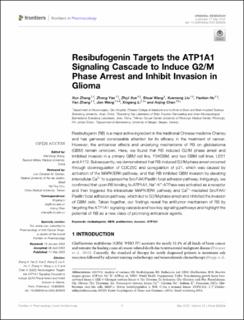| dc.contributor.author | Zhang, Xun | |
| dc.contributor.author | Yao, Zhong | |
| dc.contributor.author | Xue, Zhiyi | |
| dc.contributor.author | Wang, Shuai | |
| dc.contributor.author | Liu, Xuemeng | |
| dc.contributor.author | Hu, Yaotian | |
| dc.contributor.author | Zhang, Yan | |
| dc.contributor.author | Wang, Jian | |
| dc.contributor.author | Li, Xingang | |
| dc.contributor.author | Chen, Anjing | |
| dc.date.accessioned | 2023-03-15T13:07:22Z | |
| dc.date.available | 2023-03-15T13:07:22Z | |
| dc.date.created | 2022-09-12T12:39:56Z | |
| dc.date.issued | 2022 | |
| dc.identifier.issn | 1663-9812 | |
| dc.identifier.uri | https://hdl.handle.net/11250/3058451 | |
| dc.description.abstract | Resibufogenin (RB) is a major active ingredient in the traditional Chinese medicine Chansu and has garnered considerable attention for its efficacy in the treatment of cancer. However, the anticancer effects and underlying mechanisms of RB on glioblastoma (GBM) remain unknown. Here, we found that RB induced G2/M phase arrest and inhibited invasion in a primary GBM cell line, P3#GBM, and two GBM cell lines, U251 and A172. Subsequently, we demonstrated that RB-induced G2/M phase arrest occurred through downregulation of CDC25C and upregulation of p21, which was caused by activation of the MAPK/ERK pathway, and that RB inhibited GBM invasion by elevating intercellular Ca2+ to suppress the Src/FAK/Paxillin focal adhesion pathway. Intriguingly, we confirmed that upon RB binding to ATP1A1, Na+-K+-ATPase was activated as a receptor and then triggered the intracellular MAPK/ERK pathway and Ca2+-mediated Src/FAK/Paxillin focal adhesion pathway, which led to G2/M phase arrest and inhibited the invasion of GBM cells. Taken together, our findings reveal the antitumor mechanism of RB by targeting the ATP1A1 signaling cascade and two key signaling pathways and highlight the potential of RB as a new class of promising anticancer agents. | en_US |
| dc.language.iso | eng | en_US |
| dc.publisher | Frontiers | en_US |
| dc.rights | Navngivelse 4.0 Internasjonal | * |
| dc.rights.uri | http://creativecommons.org/licenses/by/4.0/deed.no | * |
| dc.title | Resibufogenin Targets the ATP1A1 Signaling Cascade to Induce G2/M Phase Arrest and Inhibit Invasion in Glioma | en_US |
| dc.type | Journal article | en_US |
| dc.type | Peer reviewed | en_US |
| dc.description.version | publishedVersion | en_US |
| dc.rights.holder | Copyright 2022 The Author(s) | en_US |
| dc.source.articlenumber | 855626 | en_US |
| cristin.ispublished | true | |
| cristin.fulltext | original | |
| cristin.qualitycode | 1 | |
| dc.identifier.doi | 10.3389/fphar.2022.855626 | |
| dc.identifier.cristin | 2050772 | |
| dc.source.journal | Frontiers in Pharmacology | en_US |
| dc.identifier.citation | Frontiers in Pharmacology. 2022, 13, 855626. | en_US |
| dc.source.volume | 13 | en_US |

